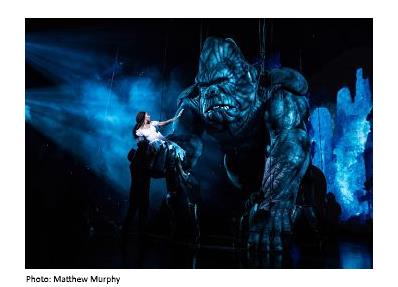

Posted 11/14/18

King Kong is a mighty creature — and his incarnation on Broadway is impressive. The sound design and creature design are technical feats, as is the puppetry and animatronics. Ditto for the video projections. And there are thrilling moments when the big ape gives chase.
But you know you’re in trouble when the mega-ton gorilla upstages the actors.
Such is the case for the $35 million Broadway musical King Kong, now at the Broadway Theater.
Based on the 1933 black-and-white film, the show offers a cinematic voyage of sorts. And voyage is the operative word. Hewing closely to its movie origins, it’s 1931 and director Carl Denham (Eric William Morris) convinces starving actress Ann Darrow (Christiani Pitts) to travel to Skull Island.
Aided by sweet-natured Lumpy (Erik Lochtefeld), Denham wants to shoot adventure, and gets it in spades when he confronts Kong, who takes a shine to feisty Ann. “He’s not a film, he’s theater!” says Denham, realizing the creature would be a surefire money-maker on stage.
The story focuses on the touching connection between King Kong, who’s not without personality, and Ann. He’s either the first gorilla to understand English, or there is a telepathic connection between people and hominids, our animal antecedents. Throw in Denham’s greed and desire to bend nature to his will and you’ve got the plot in a nutshell.
As a theme, suborning nature to a greedy exploiter is a meaty one. But writer Jack Thorne, who won a Tony for “Harry Potter and the Cursed Child,” doesn’t pursue it. King Kong is a surface experience; his very presence dwarfs everything else.
The twist here is that Ann isn’t just a collection of screams; she’s a woman with a dream. Like every young girl from rural America, she arrives in New York with one overarching goal: to be a star. Pitts’ performance boasts a strong, can-do spirit and the score, music by Marius de Vries and songs by Eddie Perfect, is fitting.
But the real audience draw is the stagecraft: sight, sound and motion. The show, directed and choreographed by Drew McOnie, is exciting as spectacle, though short on substance.
The puppetry element continues this weekend, November 17 and 18, at NYU Skirball, a sleek theater, with Fantasque, billed as a “magical dance pageant” by Dance Heginbotham and puppeteer Amy Tropetter.
Larger-than-life and small puppets, coupled with human dancers, create a fable of light and dark, augmented by an array of whimsical characters — from blue angels to giant rats. The show is seen through the eyes of a child, performed to live music composed by Ottorino Respighi, a contemporary of Puccini, and adapted from piano pieces by Giaochino Rossini.
But the magic has meaning.
When the production debuted at Bard College two years ago, Trompetter called Fantasque a tale of “good, evil and redemption.” —Fern Siegel